2020 Honda Africa Twin brakes, wheels and tyres
One of the few items left from the previous Africa Twin, the new bike features the same radial four-pot Nissin calipers on 310mm discs – but now braking performance is augmented by a cornering ABS algorithm, made possible by the new IMU’s computing power. Already as strong and powerful as you’d want on the end of forks with 230mm stroke and a 21in, 90/90 dual purpose front tyre, working in combination with the Showa semi-active suspension and Bridgestone A41 tyres, it’s hard to overstate just how much braking force – and feel – can be transmitted back to the rider.
The Adventure Sports’ wire wheels are now tubeless design, with rim-mounted spokes – giving the obvious benefit of being able to plug punctures easily. The standard Africa Twin sticks with standard spokes and so still requires a tubed tyre (more below). Sizes are as before, at 21in front and 18in rear.
All models of Africa Twin are approved for use with Bridgestone Battlax Adventurecross Tourer AX41T, Metzeler Karoo Street or, for knobbly off-road used, Continental TKC80s. Sizes are 90/90-21 front and 150/70R 18 rear.
Engine, gearbox and exhaust
In 2016 the previous Africa Twin landed in an adventure bike sweet spot, cutting a slightly more imposing and significant figure than rival mid-spec adventure bikes such as BMW’s F800GS and Triumph’s Tiger 800 – but the Honda was less bulky and ostentatious than flagship adventure bikes such as BMW’s R1200GS, Triumph’s Explorer 1200 and KTM’s 1290 Super Adventure.
Part of that positioning success was down to its 998cc, 94bhp parallel twin motor. The lump contained current, not radical, engineering – a 270° firing interval for that familiar, off-beat, tractive grumbliness, and a single camshaft spinning all eight valves for compactness (exhaust actuated by rocker arms, intake by bucket and shim). But at 94bhp it remained inside the mandatory maximum permissible for subsequent restricting down to an A2-friendly 47bhp, and technically on par with its smaller-capacity rivals.
But the Africa Twin’s larger capacity gave it a beefier, torquier bottom end than them, and added to an air of grown-up superiority. It was definitely boss in that part of the adventure bike market.
Chassis and Suspension
The semi-double-cradle frame has been modified to reduce weight and the new engine components and redesigned cases, the bike is 5kg lighter. The rear swingarm is inspired from the CRF450 MX bike in order to make the AT more nimble off-road.
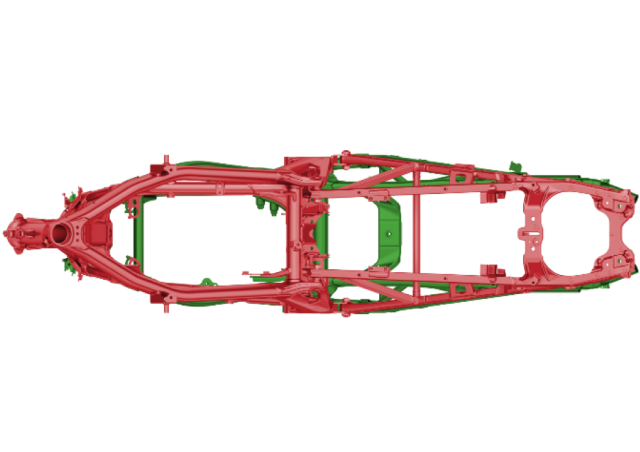
Green = Old
Red = New
The fully adjustable 45mm Showa Front suspension is plush and makes the bike feel connected to the surface. The rear fully adjustable Showa Pro-Link monoshock (with gas bottle) has 220mm of wheel travel. The suspension coped very well with the rough ‘road’ conditions, and the feeling the package provides to the rider is direct and reassuring. At no point did the bike lack feeling or responsiveness. Which is pretty good going for a 226kg machine on gravel and dirt.
For more extreme Dakar styled conditions and jumps I can’t comment on how the suspension would perform. Chances are it would be sweet as a nut though.
Honda CRF1100L Africa Twin on UK roads

We took the Honda for a spin around the UK’s toughest test route, the MCN 250, to see how it handles the lumps and bumps of real-world riding conditions.
When you stand next to it, the Honda seems tall with its 22.5mm higher bars and Dakar-style display giving it a very imposing front-end. However, throw a leg over the saddle and the Africa Twin’s narrow waist, courtesy of its compact parallel-twin motor, makes it easy to get feet flat on the floor.
Related: Best adventure motorbikes
But there is a downside as the Honda’s pegs are high, crunching up those who are longer in the limb, something that 250 miles of riding certainly highlighted, alongside the Honda’s firmer seat. But what of the taller suspension?
There was a time when long-travel suspension and a 21in front wheel equalled a wobbly ride and slightly unnerving feel from the front-end, but those days are long gone. Would I be happy keeping up with sportsbike-mounted mates? Hell yes, especially with the Africa Twin’s new motor.
Featuring more capacity for 2020, the Twin’s engine now has a much-needed dose of drama about it that the slightly gutless older version lacked. It’s not a night-and-day transformation but it is one that enhances the Twin’s character, making it a genuinely enjoyable bike to let rev out and work.
Related: How to ride a motorbike off-road
In making the base-model Africa Twin more off-road focused Honda could have totally ruined it as a road bike, however what they have actually done is make it more accomplished on the tarmac.
Yes, the screen is slightly small and the seat a touch firm in direct comparison to Triumph’s Tiger 900, but the Honda’s spirit and fun-factor is now matched by top-rate electronics and even better comfort levels thanks to its higher bars.
Ride Modes
TOUR: Employs the highest level of power (1), for touring loaded with pillion and luggage plus mid-range Engine Braking (2) with active on-road Cornering ABS. URBAN: Suits wide-ranging riding requirements and uses mid-level Power (2) and Engine Braking (2) with active on-road Cornering ABS.GRAVEL: Delivers the lowest level of Power (4) and Engine Braking (3). Cornering ABS is active with an off-road setting; in this setting, the rear brake ABS cannot be switched off.OFF-ROAD: Uses lower-mid level Power (3) and the lowest amount of Engine Braking (3). Cornering ABS is active with an off-road setting; the rear brake ABS can be switched off.USER Modes 1 & 2: Offer the rider a choice of two distinct personalized setups – choosing between Power levels 1-4 and Engine Braking 1-3, and ABS on-road/off-road parameters.
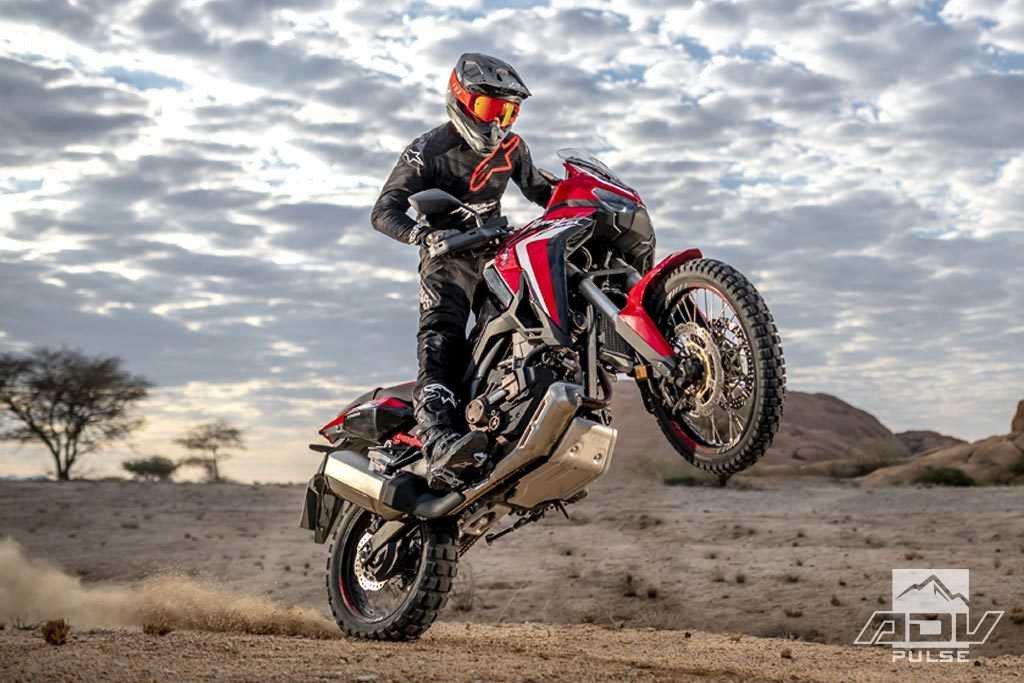

Styling, ergonomics and comfort
There are lots of detail – and some big – changes to the 2020 Africa Twin’s looks and riding position, but for many people the most significant alteration is that all three bikes now use the same seat height. Previously, the Adventure Sport model topped 900mm – which clearly put the bike out of reach (ahem) of a lot of potential customers. All bikes now come with 850-870mm seat height (with 825mm or 890mm low and high options when you buy the bike) – the seat itself is new; narrower than before at the tank, to permit easier access to the ground.
The result is where you sat ‘on’ the Adventure Sport, now – even with the seat on high – you sit ‘in’ it, very much behind the tank and screen. Which is also now five-way adjustable for height, using a pair of side clips to slide it up and down. It’s not as convenient as Ducati’s sash-window style one-handed screen, and even on its lowest setting the screen lip intrudes in my field of view – I’d rather have the short screen option from the base Africa Twin, but it won’t fit the Adventure Sport.
Wind noise and head buffeting is a highly personal thing – even two riders the same height can disagree on the severity. But for me, the touring screen on the previous Adventure Sport was a head-rattling nightmare – it was better with no screen at all. This one is better; fully upright you can get completely behind it to minimize the disturbance. But the bike really needs side wind deflectors too – which are at least available as factory accessories.
The bars – ah, that lovely gold! – are a fraction higher than previously, and can still be rotated in the clamps for fine tuning. On road I’d struggle to think of a more immediately natural riding position – its promise of long distance comfort is immediate. Lots of leg room, the seat feels nicely compliant but supportive, and only a trace of engine vibes finding their way through the pegs (especially if you take out the rubbers for off-road riding).
Honda CRF1100L Africa Twin verdict
The New 2020 CRF1100L Africa Twin is a sly beast. It’s composed, accurate, and thoroughly enjoyable to ride. In the right hands, this bike would be an absolute weapon off-road and on the streets.
In short, the formerly outgunned Africa Twin has just gotten a whole load more bite. And at the risk of sounding like I’ve developed objectophilia, I bloody love it.
Don’t just take my word for it though, book yourself a test ride and see how you feel about it.
Honda CRF1100L Africa Twin specs
|
ENGINE |
|
|
Type |
SOHC liquid-cooled 4-stroke 8-valve parallel twin with 270° crank and Uni-cam |
|
Displacement |
1084cc |
|
Bore & Stroke |
92mm x 81.5mm |
|
Compression Ratio |
10.1:1 |
|
Max. Power Output |
75kW at 7,500rpm |
|
Max. Torque |
105Nm at 6,250rpm |
|
Noise Level |
73dB |
|
Oil Capacity |
4.8/4.3 (5.2/4.7 DCT) |
|
FUEL SYSTEM |
|
|
Carburation |
PGM-FI |
|
Fuel Tank Capacity |
18.8L |
|
CO2 Emissions |
112g/km MT 110g/km DCT |
|
Fuel Consumption |
4.9L/100km (20.4km/L) MT 4.8L/100km (20.8km/L) DCT |
|
ELECTRICAL SYSTEM |
|
|
Starter |
Electric |
|
Battery Capacity |
12V-6Ah Li-ion battery (20hr) |
|
ACG Output |
0.49 kW/5,000rpm |
|
DRIVETRAIN |
|
|
Clutch Type |
Wet, multiplate with coil springs, aluminium cam assist and slipper clutch DCT – 2 wet multiplate clutches with coil springs |
|
Transmission Type |
6 speed manual (6 speed DCT) |
|
FRAME |
|
|
Type |
Semi double cradle |
|
CHASSIS |
|
|
Dimensions (L´W´H) |
2330mm x 960mm x 1395mm |
|
Wheelbase |
1575mm |
|
Caster Angle |
27.5° |
|
Trail |
113mm |
|
Seat Height |
850/870mm (low seat option 825mm, high seat option 895mm) |
|
Ground Clearance |
250mm |
|
Kerb Weight |
226kg (DCT 236kg) |
|
SUSPENSION |
|
|
Type Front |
Showa 45mm cartridge-type inverted telescopic fork with dial-style preload adjuster and DF adjustments, 230mm stroke |
|
Type Rear |
Monoblock aluminium swing arm with Pro-Link with Showa gas-charged damper, hydraulic dial-style preload adjuster and rebound damping adjustments, 220 mm rear wheel travel |
|
WHEELS |
|
|
Type Front |
21M/C x 2.15 wire spoke with aluminium rim |
|
Type Rear |
18M/C x 4.00 wire spoke with aluminium rim |
|
Rim Size Front |
21″ |
|
Rim Size Rear |
18″ |
|
Tyres Front |
90/90-21M/C 54H (tube type) (Bridgestone Battlax Adventurecross Tourer/ AX41T Metzler Karoo Street) |
|
Tyres Rear |
150/70R18M/C 70H (tube type) (Bridgestone Battlax Adventurecross Tourer/ AX41T Metzler Karoo Street) |
|
BRAKES |
|
|
ABS System Type |
2 channel with IMU Selectable ABS MODE with on-road and off-road setting |
|
Type Front |
310mm dual wave floating hydraulic disc with aluminium hub and radial fit 4-piston calipers and sintered metal pads |
|
Type Rear |
256mm wave hydraulic disc with single piston caliper and sintered metal pads. 2-channel with rear ABS OFF mode. |
|
INSTRUMENTS & ELECTRICS |
|
|
Instruments |
LCD Meter, TFT 6.5inch touch panel multi information display |
|
Security System |
Immobiliser, security alarm (optional) |
|
Headlight |
LED |
|
Taillight |
LED |
|
Electrics |
Daytime running lights, Bluetooth audio and Apple Carplay, USB socket, auto turn signal cancel, cruise control, emergency stop signal, IMU, HSTC, wheelie control |
Handling: frame, suspension and weight
It’s not often you hear a manufacturer claim to have deliberately taken rigidity out of a frame – but that’s what Honda say they’ve done with the 2020 Africa Twin’s steel double cradle, and blimey has it worked.
The aim was to get more feel for grip under steering and braking from the Africa Twin’s front end which, apart from significant fork dive, was a… ‘problem’ is too strong a word; more like ‘occasional mild disquiet’… with the previous model when you started properly tramping on, on tarmac (riding in a way I suspect few owners would contemplate, to be fair). Such is the level of development tweakery we’re at these days.
2020 Honda Africa Twin Adventure Sports (base in brackets)
|
New Price |
From £13,049 |
|
Capacity |
1084cc |
|
Bore x Stroke |
92.0mm x 81.5mm |
|
Engine layout |
parallel twin |
|
Engine details |
8v sohc, l/c |
|
Power |
100.6bhp @ 7500rpm |
|
Torque |
77.4 lb.ft @ 6250rpm |
|
Top speed |
135mph (est) |
|
Average fuel consumption |
46.2mpg |
|
Tank size |
24.8 litres (18.8 litres) |
|
Max range to empty |
250-280 miles |
|
Rider aids |
absolutely everything (see text) |
|
Frame |
steel double cradle |
|
Front suspension |
45mm Showa usd forks |
|
Front suspension adjustment |
fully adjustable (semi-active option) |
|
Rear suspension |
Showa monoshock |
|
Rear suspension adjustment |
adj. preload and rebound (semi-active option) |
|
Front brake |
2 x 310mm discs, four-pot radial calipers, cornering ABS |
|
Rear brake |
256mm disc, one-pot caliper, cornering ABS |
|
Front tyre |
90/90-R21 |
|
Rear tyre |
150/70-R18 |
|
Rake/Trail |
27.5°/113mm |
|
Wheelbase |
1575mm |
|
Seat height |
850-875mm |
|
Kerb weight (est) |
238kg; DCT: 248kg (+2kg for Showa SE) (AT: 226kg, DCT 236kg) |
|
Warranty |
unlimited miles/2 years |
|
Website |
Looking for motorcycle insurance? Get a quote for this motorbike with Bennetts bike insurance
Riding modes
|
Power |
Engine braking |
ABS |
G Switch |
HSTC |
Wheelie |
||
|
TOUR |
1 |
2 |
On road |
Not active (Default) |
Adjustable |
Adjustable |
|
|
URBAN |
2 |
2 |
On road |
Not active (Default) |
|||
|
GRAVEL |
4 |
3 |
Off road |
Not active (Default) |
|||
|
OFF-ROAD |
3 |
3 |
Off road |
Active (Default) |
|||
|
USER 1 USER 2 |
1-4 |
1-3 |
On road or Off road |
Free to choose |
Navigation of these modes on the LH switchgear does take a while to get used to. To nitpick, the indicator stalk isn’t obvious enough from the DCT gear selector either. Although I’m not that greatest at multi-tasking, so I can be easily confused.
The self-cancelling indicators aren’t the greatest either, but you can turn off this function via the dash.
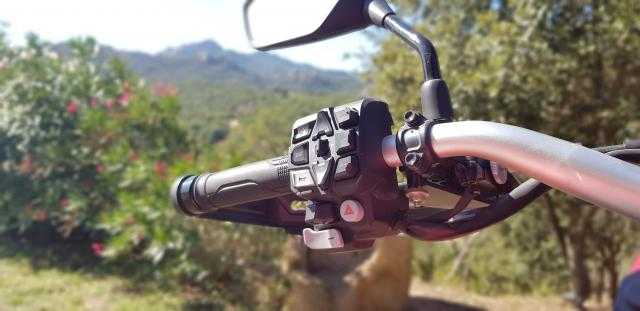
We love:
· Build quality and attention to detail
· On and off-road handling capability
· Electronics package
· Empowering riding position
We don’t love:
· Indicator stalk design
· Dash takes too long to load
· Startup safety warning on touch screen each time bike is switched on

Ride quality & brakes
3 out of 5 (3/5)
A smaller screen and 22.5mm taller bars than the previous generation, not to mention a new detachable 40mm narrower sub-frame, 1.8kg lighter chassis and revised swingarm see the Africa Twin’s off-road focus enhanced, but at the sacrifice of some road comfort levels.
While the higher bars are relaxed, the non-adjustable lower screen means you are exposed to the elements and its long distance ability is certainly compromised as a result. In an off-road environment it has certainly benefitted from these mods, but as a road bike for covering miles the Adventure Sports is a better bet.

The updated DCT gearbox (which is now linked to the IMU and responds to the bike’s angle when calculating if it should change gear or not) is excellent and now a worthy addition for either on or off-road fans.
All the electronic systems perform excellently on the road and in the two off-road modes the traction control allows you to pull off a cheeky little slide while the ABS ensures you can use the front brake with confidence on gravel when it all gets a bit too wild.
DCT v manual
The AT’s DCT (Dual Clutch Transmission) option keeps its existing mechanical system but has revised the software side of the auto gear-shifting technology, so now takes the bike’s lean angle into account and won’t change gear mid-corner in auto mode (a common complaint of the usual DCT operation).
As before, the system is super-clever – once you’re used to not having a clutch or gear lever (you can still specify a foot lever if you need one) the gear shifting is, for the most part, smooth and intelligent. As before there are four auto modes: Drive – which hunts for top gear as often as possible – and three increasing modes of Sports setting – which hang onto gears for longer. And there are still a pair of flappy paddles on the left bar cluster (how do they find the room?) for shifting manually, as long you can remember up and down.
I’m a big fan of the design and technology of DCT – it’s very, very clever – but I’m not a fan of using it because whatever situation I find myself in, I prefer having a clutch so I can control the engine – whether I’m backing it into corners for fun, or using it to help smooth out throttle transitions when going bananas. DCT is very good at automating gearchanges when you’re just cruising and riding normally (which, to be fair, I don’t find particularly onerous), but it’s not so much fun when you want to mess about doing skids and wheelies.
You do want to mess about doing skids and wheelies, right? Still, Honda say around 45% of AT sales are DCT, so many of you don’t. It’s a broad church, eh? Personally, I’d go for the manual box with optional £695 quickshifter and autoblipper every time. Especially when DCT also adds a whopping 10kg in weight and around £1000 to the price. Clever, but not today, thanks.
Engine, transmission and exhaust
The reworked cylinder head, improved valve timing, throttle body and exhaust control valve enable 101hp from the 1084cc 270° parallel-twin engine. The torque sees a 7% improvement on the last model @105Nm.
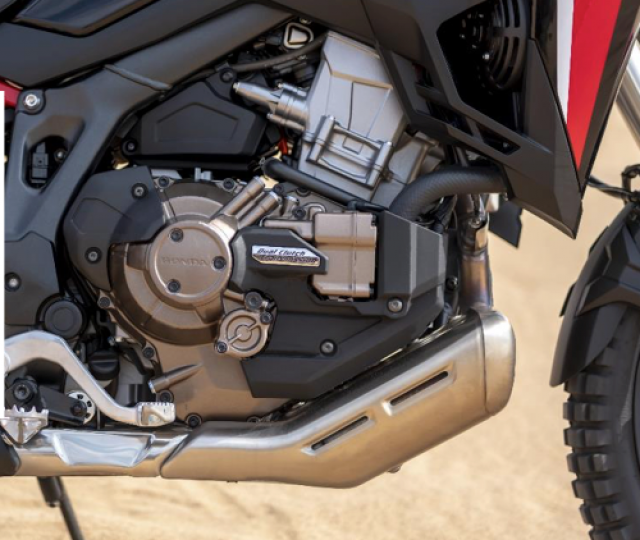
The torque is smooth and consistent from idle right up to the redline. It’s got a strong focused character with a couple of bumps of torque at 4k and 6k. And the joystick-like DCT triggers on the LH switchgear make the acceleration consistent and seamless. Like most parallel-twin motors the engine is silky smooth, and mega predictable off-road — great for technical and slippery trails where throttle accuracy is important. And great for whipping the tail out.
The DCT system, though massively improved , felt a little jerky on very technical sections of trail, and required a dab of rear brake on pull away to smooth out the initial throttle input. It’s not bad by any stretch of the imagination but could be slightly refined. However, if you’re all about offroading then the manual variant would be a better option. If you’re not an expert on the rough stuff, then the DCT system allows you to focus on the path ahead and not worry about simultaneously coordinating all four limbs at once.
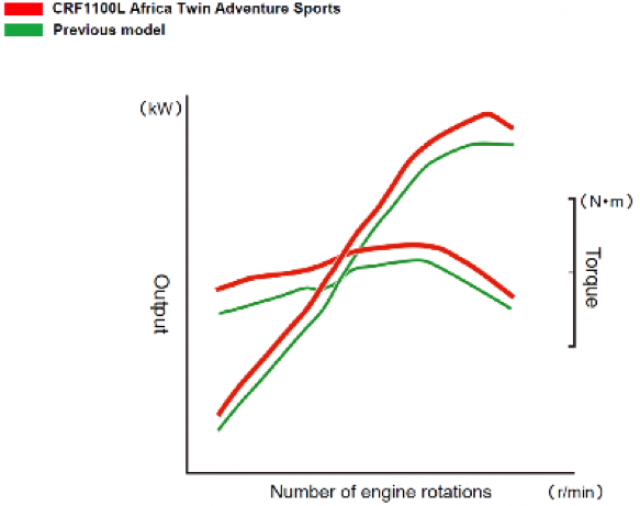
The exhaust note — thanks to the control valve — is delightful. It’s got a deep bellow and sounded the dog’s bollox as the guide riders ripped it up the gravel trails — rear wheel spinning, throttle pinned. Awesome stuff!
Equipment
4 out of 5 (4/5)
Most of the Africa Twin’s weaknesses in terms of tech have been rectified for 2020. The headline act is the all-new 6.5-inch touch screen TFT dash, which comes as standard. Incorporating Apple CarPlay, it is Bluetooth ready, can display navigation apps, has a USB charging point and can be accessed with a gloved hand. However, the touch screen is only available when the bike is stationary and Apple CarPlay requires a Bluetooth headset to be linked to function, which is annoying.
Also new is a six-axis IMU, bringing with it cornering ABS and traction control (seven levels) alongside cruise control (at last!), four power modes, three braking levels, three levels of wheelie control and four set riding modes plus two user modes. The ABS can also be turned off to the rear caliper for off-road use.
There is a DCT version, whose performance has been significantly upgraded through it being linked to the IMU, making it gradient and corner responsive in its gear selection. While the Adventure Sports has the option of semi-active suspension, this isn’t available on the stock model.
2020 Africa Twin Adventure Sports Verdict
Honda have clearly had a bit of a rethink about their positioning of the previous model Africa Twins; the idea of making the old Adventure Sport – ostensibly the tourer – harder to access with a taller seat didn’t make a lot of sense. So by labelling the standard bike the more off-road orientated and the new Adventure Sports more road and touring based, the differences suddenly make sense. Bigger tank and taller screen with the option for wafty suspension on the tourer; lighter, sharper, keener base AT for trips off-road.
This also means the Adventure Sport, with its new-found electronics whizz, gets squarely into bed alongside the GS and flagship adventure bikes – at least in terms of spec and price, but albeit deficient to the engine tune of at least 35bhp. And the base AT is still the daddy among its peers; the BMW F850GS and KTM 790 Adventure – both great at their own thing, but neither anywhere near the AT on spec or, in the KTM’s case, looks or build quality. Triumph’s forthcoming Tiger 900 might have something to say about it, though – we’ll have to wait to find out.
But in the short term (and I wouldn’t bet against the long term either) I can’t see any reason why the Africa Twin’s success won’t continue for at least another four years.
Key Changes for 2020 Africa Twin
- New Euro5-compliant 1100cc parallel twin engine produces 7% more horsepower and 6% more torque.
- Cruise Control is standard.
- 11 pounds (5kg) lighter, with 10% improvement in power to weight ratio, thanks to weight reduction in areas including engine, frame and swing arm.
- All-new 6.5” TFT Multi-Information Display incorporates Apple CarPlay and Bluetooth connectivity, with touchscreen functionality.
- Four pre-set riding modes – plus two user-selectable options – offer scenario-specific tailoring of Power, Engine Braking, Honda Selectable Torque Control, (HSTC), Wheelie Control and Cornering ABS settings.
- HSTC, plus new Cornering ABS, Wheelie Control and Rear Lift Control functions are now managed by a six-axis Inertial Measurement Unit
- Standard model itself has even sharper off-road focus.
- Adventure Sports model is more ready than ever for the long haul – and now available with cornering lights, a scooped seat and cutting-edge Showa EERA suspension as an option.
- Unique Dual Clutch Transmission still available on both models.
The Adventure Sports edition additionally receives a raft of cool and useful upgrades including Showa Electronically Equipped Ride Adjustment suspension (EERA) for optimized damping front and rear. The system includes four default modes – soft, mid, hard and off-road . There is also a “user” mode for further fine-tuning (see below for details on settings). Rear spring preload can be adjusted while the bike is stationary. Both suspension travel and ground clearance have also been lowered on the Adventure Sports model to match the standard Africa Twin for 2020.
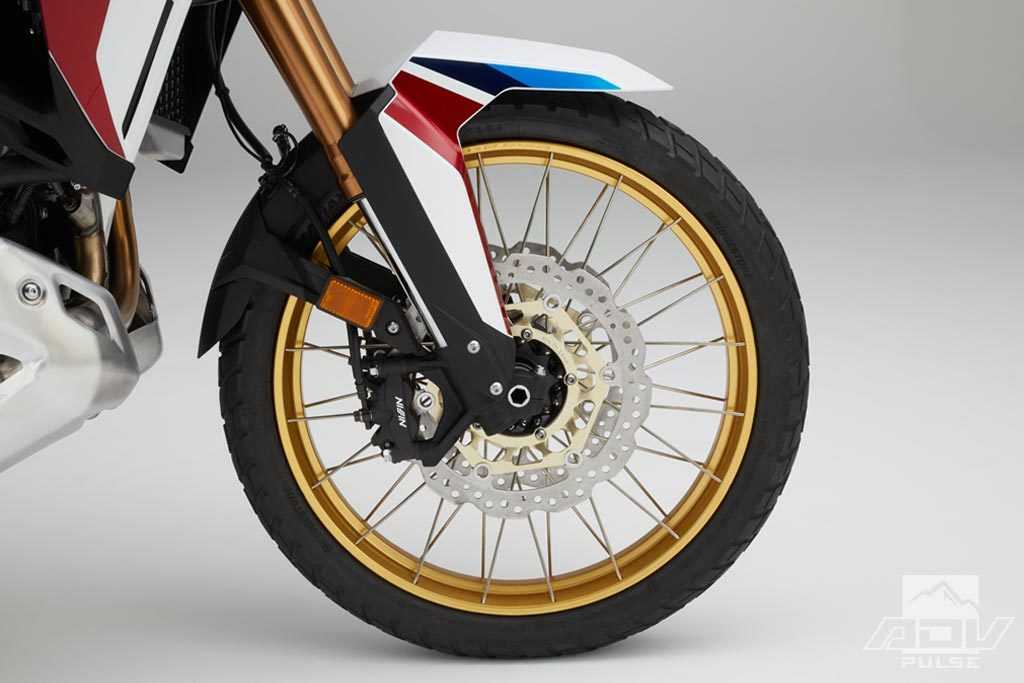 Tubeless wire-spoke wheels are now standard on the Africa Twin Adventure Sports.
Tubeless wire-spoke wheels are now standard on the Africa Twin Adventure Sports.
In other good news the Africa Twin Adventure Sports now has the same two-way adjustable seat height of the standard Africa Twin: 33.5”-34.3” (down considerably from the 35.4”-36.6” of the previous model at the expense of less suspension travel). Accessory seats are available in lower (32.5”- 33.3”) and higher (34.4”- 35.3”) two-way adjustable heights.
As expected the Adventure Sports will come with cross-spoked tubeless wheels, a larger, more substantial skid plate, new aluminum rear rack and 6.5-gallon tank. Creature comforts include heated grips and a new 12v charger socket. Its tall touring-style windscreen is adjustable to five levels as well.
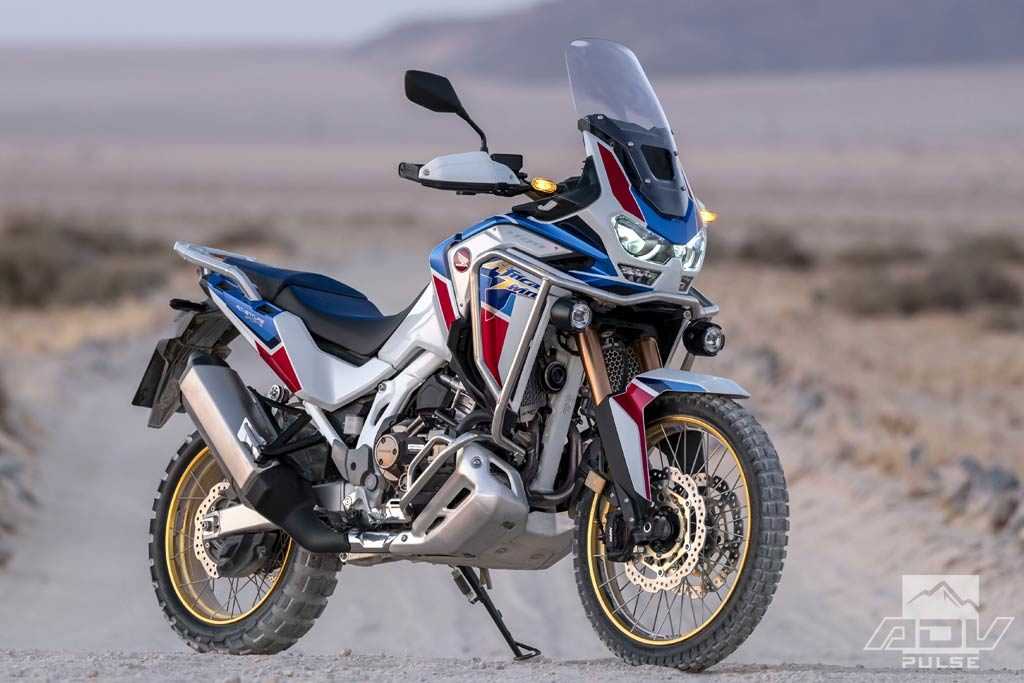
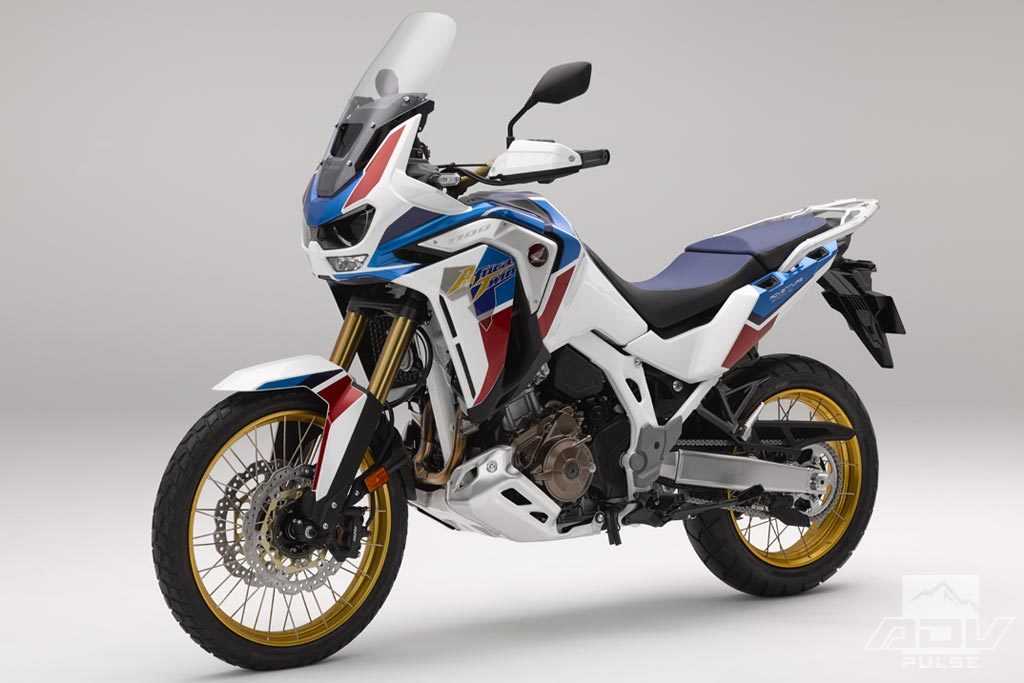 The suspension travel of the Adventure Sports model has been reduced to the same height as the standard model (9.1″ front / 8.7″ rear).
The suspension travel of the Adventure Sports model has been reduced to the same height as the standard model (9.1″ front / 8.7″ rear).
Pricing for the standard Africa Twin is up $800, with the manual version at $14,399 and its DCT counterpart going for $15,199, which seems quite reasonable for the electronic upgrades alone. However the Africa Twin Adventure Sports version, with its trick electronic suspension, is up $2,100 over 2019 pricing, with the manual shifting unit listing for $17,199 and the DCT, $17,999. Gulp.
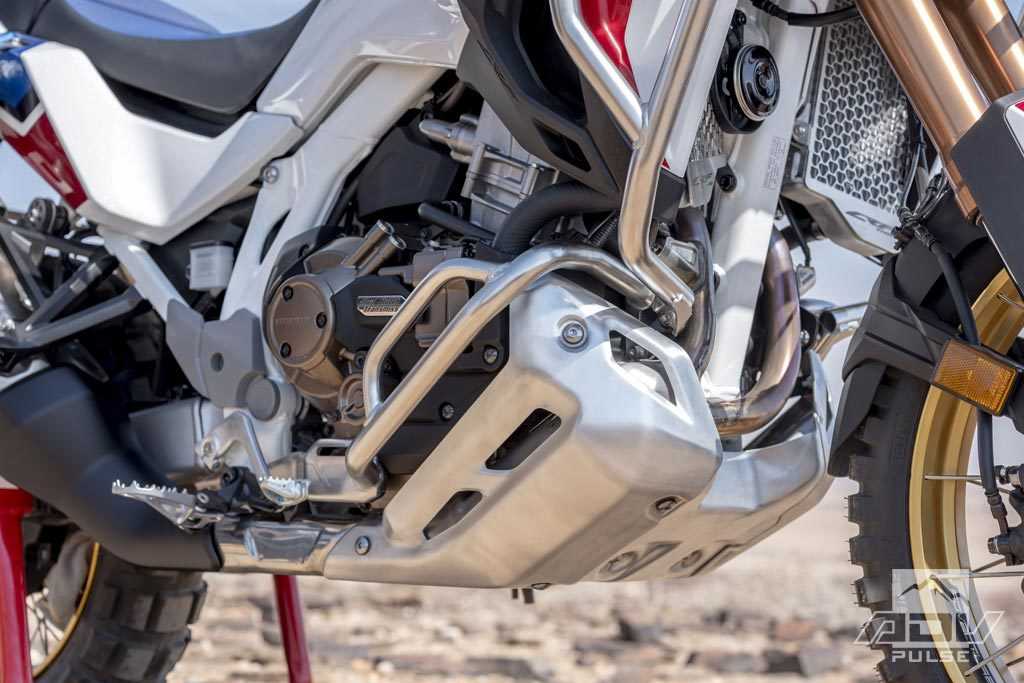
US colors for 2020 will be Matte Black Metallic only for the standard Africa Twin, while the Adventure Sports will come in Pearl Glare White/Blue. Europe will receive an additional 2 colors: Grand Prix Red for the standard, and Darkness Black Metallic for the Adventure Sports.
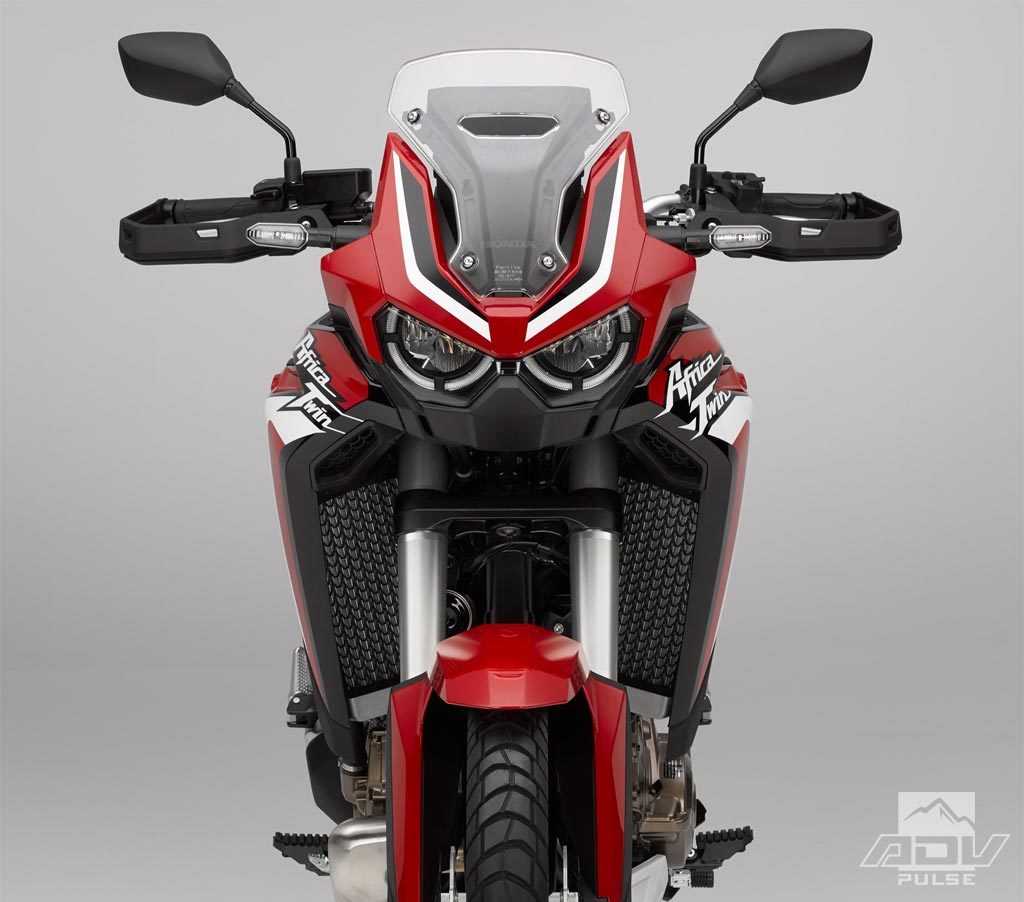
Engine
4 out of 5 (4/5)
The parallel twin has received an increase in capacity from 998cc to 1084cc for 2020 through a 6.4mm longer stroke, boosting peak power and torque by 6.8bhp and 4.4ftlb respectively while also delivering increases throughout the rev range.
While lacking the outright performance and theatre you get from BMW’s ShiftCam boxer, Honda’s parallel twin has certainly benefitted from a very welcome bit of extra pep without losing its overall feeling of refinement.
It’s not going to blow your socks off, but it is a definite improvement and certainty fulfills a touring brief with little vibes and a slick gearbox. In an off-road environment, it has lots of low-down grunt to help it search out grip and a predictable throttle connection.
Off-road performance
So does the Africa Twin still work off road? Yes, it does. The launch took in a selection of dry gravel and sandy firetrails, with a few rocks and bumps but nothing an ordinary road rider couldn’t manage without falling over. We could’ve ridden most them on a Fireblade (wouldn’t have been much fun though). The Adventure Sport coped just fine, with excellent control, plenty of electronic help (the front off-road ABS is astonishing), and not too much weight in the wrong places to distract. Is it as ‘good’ as <insert list of adventure bikes>? Depends how good you are. It’s clearly not as agile as Yamaha’s lighter Ténéré 700 or as aggressive as a KTM 790 Adventure R, but for an average off-road rider it’s less intimidating than a fully-loaded 1250GS or a 1290 Super Adventure – and much better suited than a Tiger 1200. So the 2020 AT is pretty much where it was already positioned – but the new electronics and lower seat height (on the Adventure Sport) make a small difference.
Equipment
This is, perhaps, the most obvious list of changes for the new 2020 Africa Twin – and it’s a big one so buckle up.
A central change for 2020 is the addition of a 6-axis IMU (Inertial Measurement Unit) – effectively, giving the AT complete spatial ‘awareness’ of the bike’s dynamics in real time (six axes is one more than the Fireblade; I ask which is missing from the Blade – apparently it’s the previous generation Bosch IMU that uses two gyros to calculate the theoretical position of the third; the Africa Twin knows all six at once).
The benefit of an IMU is being able to design electronic systems to better augment the riding experience, either with more performance or more safety. In the AT’s case this means cornering ABS and cornering headlights (both as standard) – both of which add safety without reducing riding pleasure.
Next, an IMU allows the development of powerful control strategies – which, on an off-road bike, means potential for allowing limited degrees of rear-wheel drifting before intervention (perfect for semi-skilled off-road riders, ahem), as well as variable wheelie control, alternative braking ABS strategies, alternate engine braking control and, in the case of the Adventure Sport fitted with Showa semi-active suspension (see below), integration with damping settings to tailor suspension performance according to lean angle and/or braking conditions. And as a final bonus, it also means DCT algorithms can now include lean angles – meaning no more auto-shifting while the bike is cornering.
Handling
In short, the handling is super composed. It’s nearly impossible to tie the bike in knots, impart due to the electronics and epic two-channel ABS system, but also down to the frame and suspension geometry. It’s almost a point a squirt kind of ride, and the more relaxed and positive you are with control inputs the better it responds.
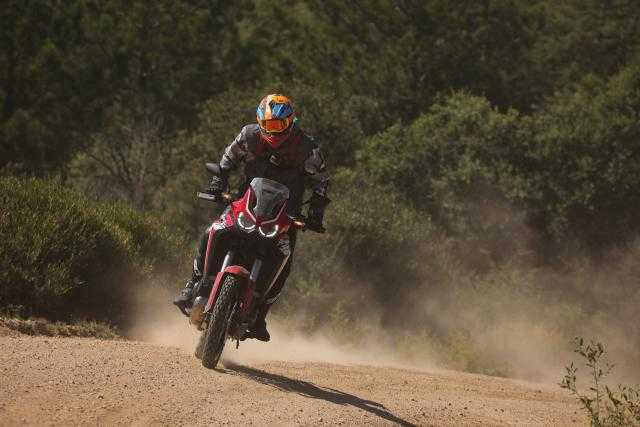
Off-road, rear-wheel steering becomes second nature, and on my brief time on the road, the Continental nobbly tyres held up just fine. Granted, you can’t ask too much of them — especially on corner exit at lean — but at non-competitive speeds, they are fine.
In my mind, the less you think about wanting to adjust suspension, preload, and rebound, the better. With the Africa Twin, I just wanted to get on and ride into the sunset. Whatever terrain is chucked in its path it just seems to calmly and efficiently overcome, and ask for more.
So. Much. Fun.
Africa Twin (base) and Adventure Sports (stock suspension)
The base Africa Twin is now aimed at being the off-road biased model – as in, it’s still predominantly a road bike, but is the one you’d prefer for spending more in off-road, and also urban, environments. This is because it’s 12kg lighter than the Adventure Sports, has an 18.8 litre tank instead of 24.8 litres (ie the same size as the previous model), and comes with a short, stubby, non-adjustable screen. It also comes with standard, fully-adjustable 45mm Showa usd forks with 230mm stroke length, and a Showa shock adjustable or preload and rebound damping only – the Adventure Sport’s semi-active system isn’t an option. The stock damping and springing are modified over the previous Africa Twin, running slightly stiffer settings to compensate for the changes to the frame rigidity.
This all makes the base 2020 bike a more agile, active ride, and adds even more pep right across the rev range. It feels like it’s been on a diet and started necking energy drinks. The base AT is more responsive, and quicker to steer with less mass both under and around you. The suspension feels harder and more intense than the Adventure Sport’s semi-active system; it’s not bad, but it’s noticeably choppier. The short screen doesn’t get in the rider’s eyeline, and lets wind blast balance your bonce.
The base AT also has different rear end bodywork, minus the clip-in panniers slots of the Adventure Sport – so aftermarket hard panniers will need a rail system of some sort.
Otherwise, the base AT has all the same good stuff as the Adventure model – same 6.5in TF dash with the same level of connectivity, same IMU system with identical electronic features, same heated grips, cruise control, USB port, 12v socket. It’s top spec stuff.
All apart from the wheel rims; the base AT has centre-spoked tubed rims instead of tubeless, which is an odd decision and one Honda were at a loss to explain. More experienced off-road riders than I say tubeless tyres are, obviously, easier to fix than tubed.
The base model Adventure Sport – without Showa semi-active – runs the same suspension as the base model, with different internal settings to compensate for the bike’s extra weight. In other respects it’s identical; on the road and off it, the ride feels less supple, choppier, by no means harsh but again, noticeably less floaty and expensive.
2020 Honda Africa Twin Economy
The 2018 Africa Twin Adventure Sports came with an enlarged, 24.2 litre tank over the base model’s 18.8 litres. Honda claimed a range of over 310 miles, which would assume fuel consumption around 60mpg (they claimed 61.2mpg in their press bumf). In the real world, with real riders in real clothes doing real riding at real speeds into real headwinds, the real economy figure varied wildly – due, no doubt, to the AT’s less than aerodynamic form. On one road test I managed to go from under 40s to over 50s (sounds like my browser history) which got me between 200 and 250 miles before a fill-up – but over 300 without carrying a spare can? Not recommended.
The new Adventure Sport has added half a litre tank volume, now up to 24.8 litres, but consumption has dropped to a claimed 57.6mpg which, according to my abacus, means the range is still just over 310 miles. Average consumption on the launch bike was 46.2mpg, which included some hard mountain roads, steady 80mph cruising, light off-road, and low- to mid-speed village-to-village riding. After 115 miles the trip reckoned the tank had 160 miles left in it, which sounds about right.
Overall rating
4 out of 5 (4/5)
The third generation of Honda Africa Twin has finally matured into the bike that so many of its fans hoped it would be from the outset.
Armed with enough of the latest electronic technology and a bit more go in its super-sized motor, it is a serious contender in the adventure bike market. But is Honda’s decision to move the stock bike more towards the off-road side the right one?
- Latest news: Honda NT1100 is Africa Twin’s touring sibling
- Latest news: 2022 Honda Africa Twin unveiled
- Related: Honda CRF1100L Africa Twin Adventure Sports review
It may be more agile than the 2020 Honda Africa Twin Adventure Sports, but I can’t help but feel UK riders will be swayed by the practicality offered by the Sports over the stock model’s rugged outlook on life and lighter overall weight. It may not be BMW R1250GS topping, but it is certainly a noticeable improvement.
From the 2021 model year, the standard Africa Twin will be available in the HRC-inspired paintjob previously reserved for the top-of-the-range Adventure Sports model.
Model history & versions
Model history
2016: Honda CRF1000L Africa Twin is launched with a 1000cc motor and at a competitive price. It was the more road-focused bike at the time.
2018: Honda CRF1000L Africa Twin Adventure Sport arrives with a bigger fuel tank, longer travel suspension and new seven-stage traction control. It was the more off-road-focused bike.
Other versions
At it’s launch, the Africa Twin stock model with DCT was priced at £13,949. The Adventure Sports is the ‘big tank’ version and as well as a larger fairing, it comes with a 24.8-litre tank, heated grips and cornering lights as standard, a five-way adjustable screen and the option of semi-active suspension.
The Africa Twin Adventure Sport ES comes with electronic suspension as an extra and was yours for £16,049 at its launch.




























